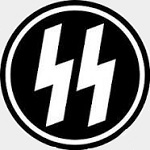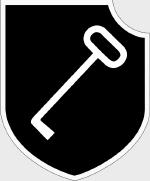Dragon DRR60070 German Sd. Kfz. 161 PzKpfw IV Ausf. G Medium Tank - "Red 205", 1.SS Panzer Grenadier Division 'LSSAH', Eastern Front, 1943 (1:72 Scale)
"If the tank succeeds, then victory follows."
- Major-General Heinz Guderian, "Achtung Panzer!"
 Just one month prior to the commencement of "Operation Typhoon" (the German assault on Moscow) the Waffenamt was scheduled to begin installing the long-barreled 7.5cm KwK gun on its new Mark IV Ausf G tanks. However, when the Wehrmacht encountered the superior Russian KV-1 and T-34 tanks during the summer campaigning season, a decision was made to mount the 7.5cm KwK40 L/43 gun onto as many existing Mark IVs as possible. Since the new gun fired larger rounds than the short-barreled gun mounted on the F1 tanks, ammunition storage capacity had to be increased and the crew compartment had to be re-arranged to accommodate the modifications.
Just one month prior to the commencement of "Operation Typhoon" (the German assault on Moscow) the Waffenamt was scheduled to begin installing the long-barreled 7.5cm KwK gun on its new Mark IV Ausf G tanks. However, when the Wehrmacht encountered the superior Russian KV-1 and T-34 tanks during the summer campaigning season, a decision was made to mount the 7.5cm KwK40 L/43 gun onto as many existing Mark IVs as possible. Since the new gun fired larger rounds than the short-barreled gun mounted on the F1 tanks, ammunition storage capacity had to be increased and the crew compartment had to be re-arranged to accommodate the modifications.
This Dragon Armor item represents a 1:72 scale tank from the 1SS. Panzer Grenadier Division "LSSAH". As such, it's painted in a winter camouflage scheme, signifying it saw action on the eastern front during the winter of 1943-44.
Now in stock!
Dimensions:
Length: 4-inches
Width: 1-1/2-inches
Release Date: April 2009
 Historical Account: "Winter Storm" - SS-Panzer Division Leibstandarte Adolf Hitler (LAH) was formed on March 17th, 1933, by Josef "Sepp" Dietrich, Hitler's bodyguard, on the order of der Fuhrer who wanted a full-time armed force that was completely loyal to him. It was attached to Heeresgruppe Sud during the invasion of Poland and later took part in the invasion of France and the Low Countries. For the most part LAH was held in reserve although it was employed against retreating British troops trapped at Dunkirk. After the British capitulation, it was attached to XIV Armeekorps during the second and final phase of the invasion of France.
Historical Account: "Winter Storm" - SS-Panzer Division Leibstandarte Adolf Hitler (LAH) was formed on March 17th, 1933, by Josef "Sepp" Dietrich, Hitler's bodyguard, on the order of der Fuhrer who wanted a full-time armed force that was completely loyal to him. It was attached to Heeresgruppe Sud during the invasion of Poland and later took part in the invasion of France and the Low Countries. For the most part LAH was held in reserve although it was employed against retreating British troops trapped at Dunkirk. After the British capitulation, it was attached to XIV Armeekorps during the second and final phase of the invasion of France.
Following the armistice, LAH was upgraded to a brigade and began training for the planned invasion of Britain (Operation
Seelowe). When the invasion was cancelled, LAH was transferred to Romania for the Balkan invasion.
It fought its way through Yugoslavia and Greece chasing Allied troops to Kalamata, where they were evacuated by sea to Crete. LAH was attached to
Heeresgruppe Sud during the initial stages of Operation: Barbarossa, seeing action at Kiev and again at the Black Sea port of Rostov. It was transferred to France for refitting in 1942 and was upgraded again, this time to a Panzergrenadier Division. It returned to the Eastern front the following year, fighting at Kharkov and then at Kursk during Operation: Zitadelle. After Kursk, LAH was sent to Italy to perform anti-partisan duties but was soon returned to the Eastern front, this time as a full-fledged Panzer Division. Following the debacle at Kamenets-Podolsk, it was sent to France for rest and refit.
LAH fought in Normandy following the Allied invasion and saw action at Caen, Falaise, and Aachen as it fell back on the German frontier. It participated in the Ardennes counteroffensive (Operation "
Wacht am Rhein") where it was attached to I SS Panzerkorps. Later on, LAH was sent back to the Eastern front to help break the siege of Budapest (Operation Margarethe). Afterwards, it was transferred to Austria where it surrendered to American troops at war's end.






![Star Trek Klingon D5 Battle Cruiser [With Collector Magazine]](http://cdn4.volusion.store/qh9e9-jdqv9/v/vspfiles/photos/EMST0102-1.jpg?v-cache=1740197136)
